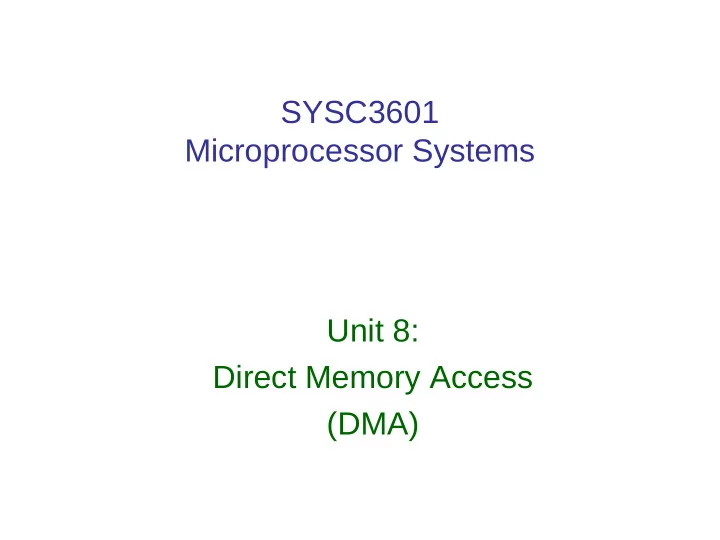

SYSC3601 Microprocessor Systems Unit 8: Direct Memory Access (DMA)
Topics/Reading 1. DMA 2. The 8237 DMA Controller Reading: Chapter 13, sections 1-2 http://www.freebsd.org/doc/en_US.ISO8859-1/books/developers-handbook/dma.html SYSC3601 2 Microprocessor Systems
Direct Memory Access (DMA) • Provides direct access to memory for I/O devices while the µ P is temporarily disabled. • Data is directly transferred between memory and the I/O device. • Transfer rates can approach 33-150 Mbyte/s – Limited only by DMA Controller speed and RAM speed – Limited to 1.6 Mbytes/s using 8237 & 8086/88 • Used for DRAM refresh, video displays, disk read/write. SYSC3601 3 Microprocessor Systems
Direct Memory Access (DMA) – Basic Operation • 2 signals are used on the µ P: – HOLD Input used to request a DMA action – HLDA Output acknowledgement, transfer busses to DMA controller • ‘DMA controller’ is essentially a special purpose µ P for conducting high speed data transfers. • During DMA transfer, the µ P is effectively disconnected from the busses. • DMA transfers data between: – memory↔I/O – memory↔memory • Not used in more advanced µ P (faster to use CPU) SYSC3601 4 Microprocessor Systems
Direct Memory Access (DMA) - Sequence 1. HOLD input raised by DMA controller 2. µ P suspends execution of its program. • Note that HOLD has higher priority than INTR or NMI and can interrupt instructions mid-stream (like RESET , whereas INTR/NMI wait for instruction to complete) 3. µ P places its address, data, and control busses in high-impedance state. 4. µ P raises HLDA to signal device that it now has complete access to the busses. 5. DMA transfer takes place. On more advanced µ P, execution continues until • system bus is required (from cache/pipeline) Device signals µ P that transfer is complete by 6. dropping the HOLD signal. 7. µ P drops HLDA . SYSC3601 5 Microprocessor Systems
Direct Memory Access (DMA) - Sequence Why HLDA only after T1 or T4? µ P input µ P output DMA transfer occurs… SYSC3601 6 Microprocessor Systems
The 8237 DMA Controller • A special purpose µ P for conducting high speed data transfers. • 4 DMA channels (0-3) • Designed to manipulate the system busses in a way similar to the µ P, but much faster. – Generates addresses and ALE – Generates bus control signals • MRDC , MWRC , IORC , IOWC • Note that these signals are not available on the 8086/88 in minimum mode – have to create using external circuitry. SYSC3601 7 Microprocessor Systems
The 8237 DMA Controller • The µ P programs the DMA controller. – How much data to transfer (size in bytes) – Where the data comes from (source) – Where the data goes (destination) • Note: on the 8237, a channel is a path between the 8237 and the memory or I/O device. – Each channel includes a DREQ request line, a DACK acknowledge line, and internal registers for address, counter, configuration, etc. – For I/O, channel acknowledge signal bypasses address decoding and activates I/O chip directly. SYSC3601 8 Microprocessor Systems
Intel 8237 SYSC3601 9 Microprocessor Systems
The 8237 DMA Controller • Ex: Memory-to-I/O DMA transfers – Only need one channel (since only 1 address). – I/O device requests transfer, provides source memory address – DACK from DMA is used to enable the I/O device (rather than decoding port address) – Channel selects memory address – MRDC and IOWC are pulled low simultaneously – Data is transferred from memory directly to I/O device. SYSC3601 10 Microprocessor Systems
The 8237 DMA Controller – Printer example JK Flip flop configured to set on falling edge of ACK ACK from printer requests another byte (char). Latch selected directly via DACK 3 instead of decoding port number. IOWC DS to printer IOWC created by 8237 tells that new as is MRDC and mem byte (char) is ready. address in this example. SYSC3601 11 Microprocessor Systems
The 8237 DMA Controller • Ex: Memory-to-memory DMA transfers – Channel 0: source address – Channel 1: destination address – A byte is read from address accessed by channel 0 an saved within the 8237 – The 8237 writes the data byte to the address selected by channel 1 – The number of bytes transferred is determined by the channel 1 count register – Memory-to-memory transfers are actually faster using the CPU (16-bit or 32-bit transfers…) SYSC3601 12 Microprocessor Systems
The 8237 DMA Controller • Transfer Modes 1. Single Mode: release HOLD after each byte is transferred. – Often used when I/O can only provide 1 byte at a time (e.g. floppy disk controller) or is very slow. 2. Demand: Tx/Rx as long as DREQ is asserted. – Can also be interrupted by external EOP signal. 3. Batch/Block Mode: automatic Tx of a block of data until counter reaches zero. 4. Cascade: Master/Slave arrangement of more than one 8237. SYSC3601 13 Microprocessor Systems
Use of DMA in multi-processor environment SYSC3601 14 Microprocessor Systems
Recommend
More recommend